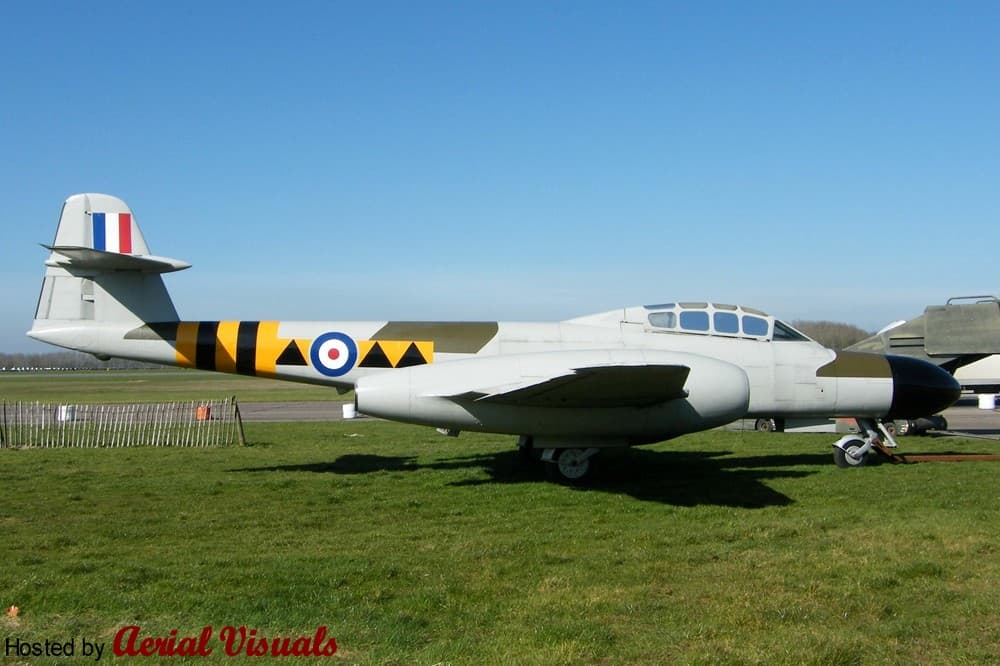- Yes
- No
Armstrong Whitworth Meteor NF.13
Vehicle design and service history:
The Gloster Meteor made its maiden flight on the 5th of March 1943, and would go one to be the first mainline service British jet fighter to enter squadron service. Due to this first mover advantage, a large number of variants would be developed with many entering service, such as the improvements made between the fighter F.3, F.4 and F.8, to more role-specific versions like the FR.9 and the subject of this suggestion today, the NF.11 night fighter variant.
The NF.11 started life as a requirement to replace the increasingly obsolete de Havilland Mosquito night fighters then in service with the RAF for nocturnal air defense. To meet this requirement put forth by the air ministry, Gloster proposed a design based on their pre-existing two-seater training variant of the Meteor, the T.7, itself a modified version of the F.4. The layout for the T.7 had the pilot in the front seat, and the navigator in the rear.
Once work began, though, the project was quickly transferred to Armstrong Whitworth, who were tasked with performing both a detailed design process and production of the then accepted type. In order to accommodate the radar suite necessary to be an all-weather fighter, the 4 20mm Hispano V cannons found in the nose of the normal fighter meteors had to be moved to the wings, outboard of the engines. Interestingly, though the NF.11 was based on the T.7, it used the fuselage and tail of the F.8 combined with the longer wings of the F.3 in order to more easily accommodate the aforementioned cannons. The final modification was the extension of the nose to contain the AI Mk 10 (the 1940s Westinghouse SCR-720) Air Intercept radar. The addition of a ventral fuel tank and wing-mounted drop tanks completed the modifications in the 4 prototypes, and the type was accepted into service as the Armstrong Whitworth Meteor NF.11.
This first prototype would fly in May of 1950, and would be the first of 324 NF.11’s that would be eventually built, 311 of which would see service with the RAF. Due to British obligations in the middle east and Mediterranean, a tropicalized version of the NF.11 was required in order to equip 39 squadron based in Malta and 219 squadron based in Egypt. To equip these squadrons 40 aircraft were ordered from Armstrong Whitworth; these frames would go on to be designated the NF.13 and were essentially an NF.11 with three modifications. The first and likely most appreciated by the crew was the addition of air conditioning, served by cold air inlets situated on the fuselage just forward of the ventral tank. In addition, distance measuring equipment was installed, resulting in additional aerials being installed on the wings, along with a radio compass fitted with a small loop aerial at the rear of the canopy. These latter two additions were added to aid navigation over the desert environment in lessons learned during ww2. In order to increase airflow the air intakes were also widened, resulting in 440 kN (45 kgp / 100 lbf) more thrust. Apart from these changes, the aircraft’s performance was identical to the NF.11, and the first airframe was test flown on the 21st of December 1952, with the type seeing adoption the following year. The NF.13 would serve during the Suez crisis, before being phased out for newer designs in the late 1950’s.
Vehicle specification:
Engine: Two Rolls-Royce Derwent 8 engines
Thrust: 3,800lb/ 16.4kN each
Span: 43ft
Length: 48.5ft
Gross Weight: 16,542lb
Maximum level speed at sea level: 580mph
Maximum level speed at 30,000ft: 547mph
Rate of climb at sea level: 4,800ft
Ceiling: 40,000ft
Cruise Range at normal load: 860 miles
Radar: AI Mk. X (SCB-720)
Armament: 4 x Hispano Mk. V 20mm cannons in wings
Additional historical images:


Sources:
- NF Meteors: The RAF’s First Jet Night-Fighters (Good article covering the development of the night fighter meteors as well as their service)
- Gloster Meteor - Wikipedia (Wiki page for the Meteor family)
*Aviation photographs of Gloster Meteor NF13 : ABPic (Additional photos of nf.13’s) - Gloster Meteor (Additional history source)



